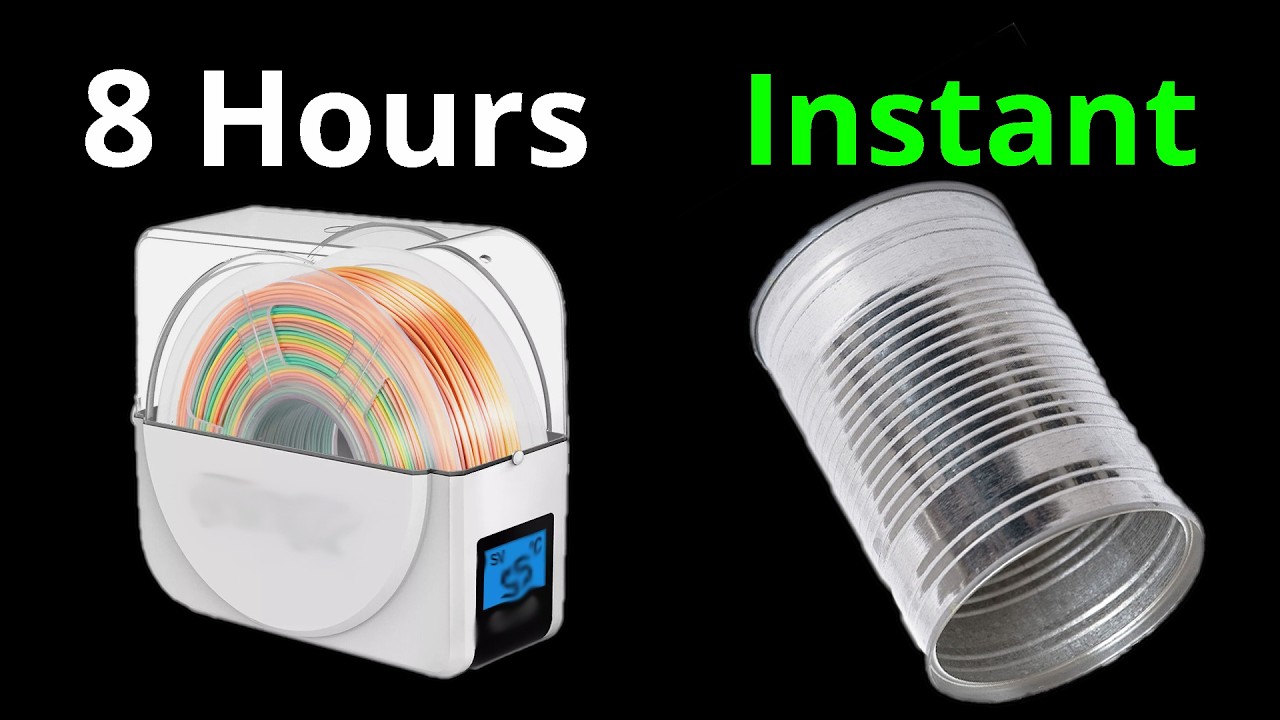Super simple prototype but if it works… Very cool idea!
This is a very good start. It will have limited effectiveness depending how exactly wet the filament is though, as the diffusion speed of water in plastic is low and it takes time to get the water actually out of the center to the surface to evaporate. The few minutes a filament sits in the inline dryer might be OK for surface moisture but will fail with wetter spools.
I think the ideal system would be to have a dry box that the heating unit and fan blow into, but then feed the filament out to the printer through a “stove pipe” that acts as the dry box exhaust. This way you’re still drying the whole spool over time but then get that “final blast” to ensure the surface is as dry as possible. Make sure to insulate all walls such that you reduce how much heat you lose as the air passes through.
Yeah, I’m definitely interested to see some experiments. I was surprised it worked as well as it did but if it does it’d be super useful
I had wondered about this as well and think it’s an awesome idea. Combo of good dry storage and printing from an active dry box seem to make this a non issue for me, but I like the idea. Maybe a coil of ptfe tubing that is fenestrated and with dessicant, a bit of heat and proper fan could do this quickly with minimal resistance. I bet its possible. I paid $45 I think for my firefly box. To me, I would place A value of about $90 on a system that did this well.
Argh finally someone tries the obvious solution. I was already considering it but was demotivated since it seemed so obvious and nobody seemed to have done it before.
This device could also probably be printed in PLA. I can’t wait until I get my lab power supply so I can give this a try with a wire coil heater.
Edit: you could even mount some PTFE tubing mounted below a heated bed and pass air through it. That way you could potentially get away without a heating element and re-use some power usually lost.
I thought it was pretty common knowledge that these dryers lack airflow. There are tons of printable wedges in printables.com and thingiverse.com to keep the lid open.
This alone speeds up drying massively. Adding a small fan to the opening might be even better but I never found it necessary.
Maybe. I actually have a dehydrator I use with plenty of airflow.
But I think that only solves part of the problem because that makes it really good at drying the outside but it’s still going to have trouble past the first couple layers. I think the fact moisture would also have a hard time penetrating means current options work well enough.for most people.
Anecdotally I can support this, recently I had a particularly old roll of petg that I dried for a larger print and later in the print started getting all stringy and messy.
I guess it depends on where you are. Where I am the air is a lot less humid than in other places, and I have the opposite effect. I put the filament roll in the dryer and start printing. As time passes, like the filament gets dryer and stringing reduces.
I doubt this will work with faster printing materials. 40mm/s is suuuuper slow compared to speeds that most modern printers are spitting filament with (not necessarily TPU). Unless you have a coil or something inside the tube heater so it spends longer time in there, but that probably also introduces a lot of resistance so moving the material through is notably harder.
Wonder if you could use some sort of buffer system to extend the time in the dryer
What about a pre-extruder or a set (or pultruder?) that brings it to just below the glass transition temp, but still at the original filament size? Water boils off, plastic is left!
You “just” need a longer distance inside the drying chamber. This could be achieved by coiling up the space where the filament travels through and guide hot and dry air through that space, ideally from the outlet towards the inlet. That air could maybe be pulled from the hotend cooler.
This could be achieved by coiling up the space where the filament travels through
Yes, that’s also what I already mentioned in the other comment…
“Unless you have a coil or something inside the tube heater so it spends longer time in there”
but as I also mentioned, pulling filamennt through a coil will also introduce significantly more resistance than pulling (or pushing if using bowden) it straight, which might be an issue at high speeds and cause under extrusion.
Sorry, I completely didn’t read all of your comment. You’re right about resistance but then again the filament won’t need to touch the enclosing coil at a large surface. In the usual bowden tubes, you have a lot of contact surface between tube and filament but this would not need to be the case in the drying coil. In the end it would all depend on the application. I’m not interested in very high speed printing (yet) because my machines are all pretty slow :).
This was a great video. I enjoyed the creator’s off key humour, for once.




